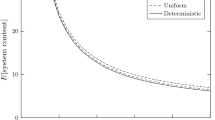Abstract
We obtain the sojourn time probability distribution function at equilibrium for a Markov modulated, multi-server, single queue with generalised exponential (GE) service time distribution and compound Poisson arrivals of both positive and negative customers. Such arrival processes can model both burstiness and correlated traffic and are well suited to models of ATM and other telecommunication networks. Negative customers remove (ordinary) customers in the queue and are similarly correlated and bursty. We consider both the cases where negative customers remove positive customers from the front and the end of the queue and, in the latter case, where a customer currently being served can and cannot be killed by a negative customer. These cases can model an unreliable server or load balancing respectively. The results are obtained as Laplace transforms and can be inverted numerically. The MM CPP/GE/c G-Queue therefore holds the promise of being a viable building block for the analysis of queues and queueing networks with bursty, correlated traffic, incorporating load balancing and node-failures, since the equilibrium behaviour of both queue lengths and response times can be determined in a tractable way.
Similar content being viewed by others
References
J. Artalejo, G-networks: A versatile approach for work removal in queueing networks, European J. Oper. Res. 126 (2000) 233-249.
R. Chakka and P.G. Harrison, A Markov modulated multi-server queue with negative customers-The MM CPP/GE/c/L G-queue, Acta Informatica 37 (2001).
J.M. Fourneau, E. Gelenbe and R. Suros, G-networks with multiple classes of positive and negative customers, Theoret. Comput. Sci. 155 (1996) 141-156.
J.M. Fourneau and M. Hernandez, Modelling defective parts in a flow system using G-networks, in: Second Internat. Workshop on Performability Modelling of Computer and Communication Systems, Le Mont Saint-Michel, June 1993.
E. Gelenbe, Random neural networks with positive and negative signals and product form solution, Neural Comput. 1(4) (1989) 502-510.
E. Gelenbe, ed., Feature issue on G-networks, European J. Oper. Res. 126 (2000).
P.G. Harrison and N.M. Patel, Performance Modelling of Communication Systems and Computer Architectures (Addison-Wesley, Reading, MA, 1993).
P.G. Harrison and A. de C. Pinto, An approximate analysis of asynchronous, packet-switched banyan networks with blocking, Performance Evaluation 19 (1994) 223-258.
P.G. Harrison and E. Pitel, Sojourn times in single server queues with negative customers, J. Appl. Probab. 30 (1993) 943-963.
P.G. Harrison and E. Pitel, Response time distributions in tandem G-networks, J. Appl. Probab. 32 (1995) 224-246.
I. Mitrani, Probabilistic Modelling (Cambridge Univ. Press, Cambridge, 1998).
I. Mitrani and R. Chakka, Spectral expansion solution for a class of Markov models: Application and comparison with the matrix-geometric method, Performance Evaluation J. 23 (1995) 241-260.
V. Naoumov, U. Krieger and D. Wagner, Analysis of a multi-server delay-loss system with a general Markovian arrival process, in: Matrix-Analytical Methods in Stochastic Models, eds. S.R. Chakravarthy and A.S. Alfa (Marcel Dekker, New York, 1997) pp. 43-66.
M. Neuts, Matrix-Geometric Solutions in Stochastic Models: An Algorithmic Approach (Dover, New York, 1994).
Author information
Authors and Affiliations
Rights and permissions
About this article
Cite this article
Harrison, P. The MM CPP/GE/c G-Queue: Sojourn Time Distribution. Queueing Systems 41, 271–298 (2002). https://doi.org/10.1023/A:1015842221910
Issue Date:
DOI: https://doi.org/10.1023/A:1015842221910




